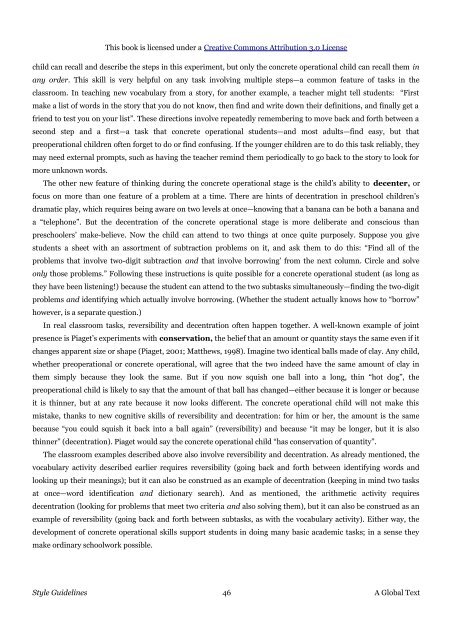Educational Psychology Third Edition Kelvin Seifert and Rosemary ...
Educational Psychology Third Edition Kelvin Seifert and Rosemary ...
Educational Psychology Third Edition Kelvin Seifert and Rosemary ...
You also want an ePaper? Increase the reach of your titles
YUMPU automatically turns print PDFs into web optimized ePapers that Google loves.
This book is licensed under a Creative Commons Attribution 3.0 License<br />
child can recall <strong>and</strong> describe the steps in this experiment, but only the concrete operational child can recall them in<br />
any order. This skill is very helpful on any task involving multiple steps—a common feature of tasks in the<br />
classroom. In teaching new vocabulary from a story, for another example, a teacher might tell students: “First<br />
make a list of words in the story that you do not know, then find <strong>and</strong> write down their definitions, <strong>and</strong> finally get a<br />
friend to test you on your list”. These directions involve repeatedly remembering to move back <strong>and</strong> forth between a<br />
second step <strong>and</strong> a first—a task that concrete operational students—<strong>and</strong> most adults—find easy, but that<br />
preoperational children often forget to do or find confusing. If the younger children are to do this task reliably, they<br />
may need external prompts, such as having the teacher remind them periodically to go back to the story to look for<br />
more unknown words.<br />
The other new feature of thinking during the concrete operational stage is the child’s ability to decenter, or<br />
focus on more than one feature of a problem at a time. There are hints of decentration in preschool children’s<br />
dramatic play, which requires being aware on two levels at once—knowing that a banana can be both a banana <strong>and</strong><br />
a “telephone”. But the decentration of the concrete operational stage is more deliberate <strong>and</strong> conscious than<br />
preschoolers’ make-believe. Now the child can attend to two things at once quite purposely. Suppose you give<br />
students a sheet with an assortment of subtraction problems on it, <strong>and</strong> ask them to do this: “Find all of the<br />
problems that involve two-digit subtraction <strong>and</strong> that involve borrowing’ from the next column. Circle <strong>and</strong> solve<br />
only those problems.” Following these instructions is quite possible for a concrete operational student (as long as<br />
they have been listening!) because the student can attend to the two subtasks simultaneously—finding the two-digit<br />
problems <strong>and</strong> identifying which actually involve borrowing. (Whether the student actually knows how to “borrow”<br />
however, is a separate question.)<br />
In real classroom tasks, reversibility <strong>and</strong> decentration often happen together. A well-known example of joint<br />
presence is Piaget’s experiments with conservation, the belief that an amount or quantity stays the same even if it<br />
changes apparent size or shape (Piaget, 2001; Matthews, 1998). Imagine two identical balls made of clay. Any child,<br />
whether preoperational or concrete operational, will agree that the two indeed have the same amount of clay in<br />
them simply because they look the same. But if you now squish one ball into a long, thin “hot dog”, the<br />
preoperational child is likely to say that the amount of that ball has changed—either because it is longer or because<br />
it is thinner, but at any rate because it now looks different. The concrete operational child will not make this<br />
mistake, thanks to new cognitive skills of reversibility <strong>and</strong> decentration: for him or her, the amount is the same<br />
because “you could squish it back into a ball again” (reversibility) <strong>and</strong> because “it may be longer, but it is also<br />
thinner” (decentration). Piaget would say the concrete operational child “has conservation of quantity”.<br />
The classroom examples described above also involve reversibility <strong>and</strong> decentration. As already mentioned, the<br />
vocabulary activity described earlier requires reversibility (going back <strong>and</strong> forth between identifying words <strong>and</strong><br />
looking up their meanings); but it can also be construed as an example of decentration (keeping in mind two tasks<br />
at once—word identification <strong>and</strong> dictionary search). And as mentioned, the arithmetic activity requires<br />
decentration (looking for problems that meet two criteria <strong>and</strong> also solving them), but it can also be construed as an<br />
example of reversibility (going back <strong>and</strong> forth between subtasks, as with the vocabulary activity). Either way, the<br />
development of concrete operational skills support students in doing many basic academic tasks; in a sense they<br />
make ordinary schoolwork possible.<br />
Style Guidelines 46 A Global Text


